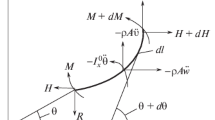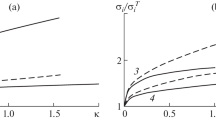Abstract
The strains in the material are calculated on the basis of a compound mechanical model consisting of a system of individual elastico-viscous models of the Maxwell type. This model makes it possible to allow for the time dependence of the temperatures and stresses in the cross sections of bodies of simple shape—rod, plate, thin-walled shell—and to calculate the strains under nonstationary temperature conditions from the creep curves for reinforced plastics with allowance for the previous loading history both under a constant load and for an arbitrary loading law.
Similar content being viewed by others
References
V. I. Feodos'ev, Design of Thermally Stressed Parts [in Russian], Oborongiz, 1963.
O. F. Shlenskii, Plast. massy, 7, 1963.
O. F. Shlenskii, Plast. massy, 1, 1964.
A. E. Kalinnikov, Mekh. polim. [Polymer Mechanics], 2, 59, 1965.
S. D. Ponomarev, et al., Strength Calculations in Machine Building, [in Russian], Mashgiz, 2, 1958.
L. M. Kachanov, Theory of Creep [in Russian], Moscow, 1960.
A. A. Popov, Grapho-Analytical Methods in Engineering Strength Calculations [in Russian], Moscow, 1964.
Author information
Authors and Affiliations
Additional information
Mekhanika Polimerov, Vol. 2, No. 3, pp. 413–420, 1966
Rights and permissions
About this article
Cite this article
Shlenskii, O.F., Plisko, V.F. Grapho-analytical method of calculating the deformation of a viscoelastic rod in axial tension under nonstationary temperature conditions. Polymer Mechanics 2, 257–262 (1966). https://doi.org/10.1007/BF00860296
Issue Date:
DOI: https://doi.org/10.1007/BF00860296




